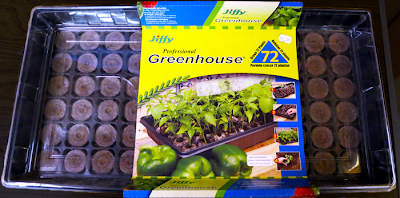Storebought Greenhouse Experiment: Jiffy vs. Burpee Greenhouse Kits
Part 1: Jiffy Professional Greenhouse 72 Cell System
This year, I wanted to start my seedlings indoors to get a head start on the growing season. Most of the vegetable and flowers I'm growing need to grow for 6-8 weeks before transplanting.
Here in Georgia, starting seeds in January is perfectly viable. I've already made a fluorescent light hanger so all I need are seeds to start.
Between my vegetable garden and all the flowerpots, I'll need a few hundred seedlings. I bought two brands of greenhouse kits to try out: the Burpee 72 Cell Greenhouse Kit and the Jiffy Professional Greenhouse 72 Cell Kit.
I'm starting with the latter.
What I liked about this are the peat pellets. You can buy more pellets and reuse the plastic bits over and over. So that could come in handy.
Step One: Pour 10 1/2 c. warm water evenly over the pellets.
Step Two: The pellets are 1 - 1 1/2 in. long when fully expanded, pour off any excess water after pellets have finished expanding.
Step Three: Pull back netting on top of pellets. Fluff and level the top.
Step Four: Sow 2-3 seeds per pellet, following the directions on the seed packet.
I sowed peas, green beans, marigolds, and columbines. According to the seed packets, the marigolds should emerge first, followed by the peas and green beans a week later, and then after a month has passed, the columbines.
Note: In the picture above, there is only one seed. I only used one green bean seed per pellet. That was a bad idea. You will find out why later.
Step Five: Place dome on tray and keep in a warm location away from direct sunlight.
Directly under fluorescent lights are fine, however.
Two weeks later, I have seedlings! On the left, I have green beans. In the middle, peas. On the right, marigolds. No columbines yet but that should be a few more weeks.
I haven't had to water it yet - the pellets have yet to turn light brown. On the downside, several of the peat pellets have grown mold! All of the marigolds came up, most of the peas as well, but not many green beans.
I'm not sure if it's because of the mold, the fact that they needed to be planted further down in the soil (seed packet said 2 in. deep, peat pellet is only 1 1/2 in.), or some other reason. Like only using one seed per pellet...
So I have mixed results with this greenhouse so far. Let's see how the other one does.

























